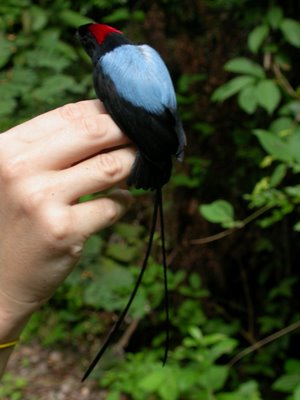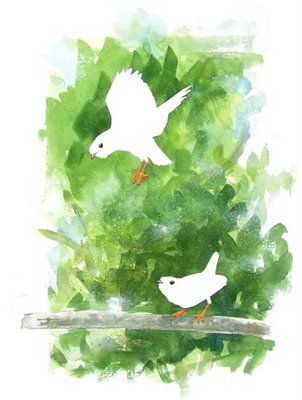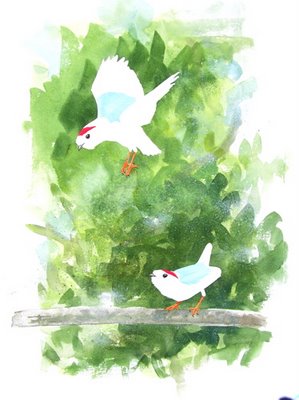Making Manakins, 3
 Look how tiny they are. About the size of a goldfinch, that's all. They're little. But oh, my!
Look how tiny they are. About the size of a goldfinch, that's all. They're little. But oh, my!O boy oboy oboy now I get to paint the birds! The only alloy on my joy is that I don't have a specimen to work from, and Stephanie Doucet, the giftee, has written her thesis on plumage coloration in long-tailed manakins. So the pressure's on to get the colors right. I'm so thankful for my terrific Mac and its color fidelity. These photos look darn close to what I remember from my one encounter with the species years ago. I've just got to hope I can get it close enough for a cigar. If I had just gotten my PhD (don't hold your breath), I would definitely light up a cigar.
The male long-tailed manakin stays in greenish juvenal plumage for five years--longer than most bald eagles! There aren't any temperate zone passerines that do that. OK, manakins are suboscine passerines, but still...they're so small. You just wouldn't expect a juvenal plumage to persist that long in such a small species. And as you might expect with such a long period in juvenal plumage, they're still going strong at ten years of age. There is so much strange stuff going on in the tropics--low clutch sizes (like two eggs)--great longevity in very small birds--cooperative breeding displays between males--lekking--things we don't see in "our" breeding songbirds. The way I think about it, it's probably all linked to food resources. What we see in temperate and boreal forests is huge sudden flushes of insect food come spring, and lots of short-lived bird species raising big brood after big brood in the short months while the flush lasts. Down in the tropics, there are no such sudden flushes of high-protein insect prey. And there are lots and lots of egg and nest predators. Birds live differently, forage differently, breed differently. You're not going to lay six eggs in an open-cup nest in Costa Rica if
a. you can't find that much high-protein food for your young when they hatch or
b. a vine snake's going to climb up and eat the clutch, anyway. This highly over-simplified take on the breeding biology of small tropical birds is brought to you by Out the Top of My Hat Productions. Don't quote me. I'm just thinking out loud. I just wanted to give you an example of the kinds of things that run through my mind while I'm painting. It's like taking a brief vacation to Central America for me to paint these birds. I get to wonder as I wander through their feathers.

The thing about watercolor is that you have to paint the light, bright colors first, and then add the dark ones. So much as I would like to save the manakins' blue mantles and red crown patches for dessert, I have to paint them first, so I can then tickle the black edges into them. In transparent watercolor, I don't have the option of painting light blue over black. I start with the crazy orange legs and feet.
Then I move on to the backs and crowns. Now I'm really having fun.
 To be continued!
To be continued!






<< Home